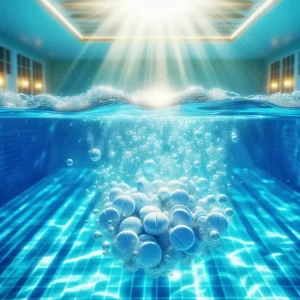Chlorine tablets are widely used in swimming pools to disinfect water and maintain hygiene standards. However, achieving the correct chlorine concentration is crucial to ensure effective disinfection while safeguarding the health and safety of swimmers. In this comprehensive article, we will explore the significance of proper chlorine concentration in swimming pool disinfection, factors influencing chlorine levels, methods for monitoring and adjusting chlorine concentration, and the importance of maintaining balance for optimal pool water quality.
Understanding Chlorine Disinfection in Swimming Pools
Chlorine is a commonly used disinfectant in swimming pools due to its effectiveness in eliminating bacteria, viruses, algae, and other contaminants. Chlorine tablets, also known as pool shock or chlorine shock, are slow-dissolving tablets containing stabilized chlorine compounds, typically dichloroisocyanuric acid (DCCA) or trichloroisocyanuric acid (TCCA). When added to pool water, these tablets release chlorine, which reacts with organic matter to sanitize the water.
Importance of Proper Chlorine Concentration
Maintaining the appropriate chlorine concentration in swimming pools is critical for several reasons:
Disinfection: Chlorine concentration within the recommended range ensures effective disinfection, eliminating harmful pathogens and preventing waterborne illnesses among swimmers.
Algae Control: Adequate chlorine levels inhibit the growth of algae, preventing the formation of green, slimy surfaces and maintaining the pool’s aesthetic appeal.
Oxidation: Chlorine acts as an oxidizing agent, breaking down organic contaminants such as sweat, oils, and urine, thereby improving water clarity and reducing unpleasant odors.
Safety: Proper chlorine concentration helps create a safe swimming environment by minimizing the risk of waterborne diseases and microbial infections.
Factors Influencing Chlorine Levels
Several factors can influence chlorine levels in swimming pools, including:
Bather Load: The number of swimmers and their activities contribute to organic contaminants in the water, requiring higher chlorine levels to maintain disinfection.
Temperature: Warmer temperatures accelerate chlorine consumption, necessitating more frequent monitoring and adjustment of chlorine levels.
pH Level: The pH level of pool water affects the efficacy of chlorine. High pH levels can reduce chlorine’s effectiveness, while low pH levels can lead to rapid chlorine depletion.
Sunlight Exposure: Ultraviolet (UV) radiation from sunlight degrades chlorine, leading to chlorine loss and reduced disinfection capacity. Stabilizers such as cyanuric acid help protect chlorine from UV degradation.
Monitoring and Adjusting Chlorine Concentration
Regular monitoring of chlorine concentration is essential to ensure optimal disinfection and water quality. Various methods are available for measuring chlorine levels in swimming pools:
Test Kits: Pool water test kits provide accurate measurements of free chlorine, total chlorine, and combined chlorine levels. Regular testing, ideally conducted daily or at least several times per week, helps maintain chlorine within the desired range.
Automatic Testers: Automated systems equipped with sensors can continuously monitor chlorine levels and adjust chlorine dosing accordingly, ensuring consistent disinfection without manual intervention.
Chemical Feeders: Chlorine feeders or dosing pumps automatically dispense chlorine into the pool based on water flow rates and desired chlorine levels, offering precise control over disinfection.

Maintaining Balance for Optimal Water Quality
In addition to chlorine concentration, maintaining balance in other water parameters is crucial for optimal water quality:
pH Level: The ideal pH range for pool water is typically between 7.2 and 7.6. Proper pH balance ensures chlorine effectiveness and prevents skin and eye irritation.
Total Alkalinity: Total alkalinity acts as a buffer, stabilizing pH levels and preventing rapid fluctuations. The recommended total alkalinity range is 80-120 ppm (parts per million).
Calcium Hardness: Calcium hardness refers to the concentration of calcium ions in water. Proper calcium hardness levels (200-400 ppm) help prevent corrosion of pool surfaces and equipment.
Conclusion
Maintaining proper chlorine concentration in swimming pool disinfection is essential for effective sanitation, algae control, oxidation, and ensuring a safe swimming environment. Factors such as bather load, temperature, pH level, and sunlight exposure influence chlorine levels and require regular monitoring and adjustment. By maintaining balance in chlorine concentration and other water parameters, pool owners can achieve optimal water quality, enhance swimmer safety, and prolong the lifespan of pool infrastructure. Regular testing, monitoring, and maintenance practices are key to achieving and maintaining the desired chlorine concentration, contributing to a clean, inviting, and enjoyable swimming experience for all.





